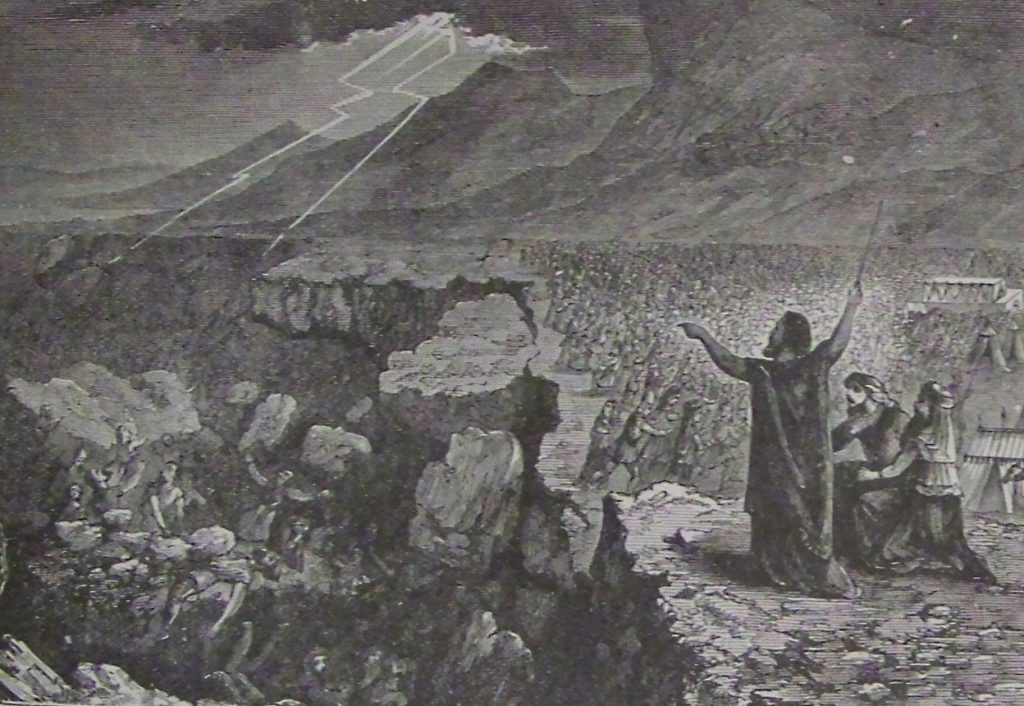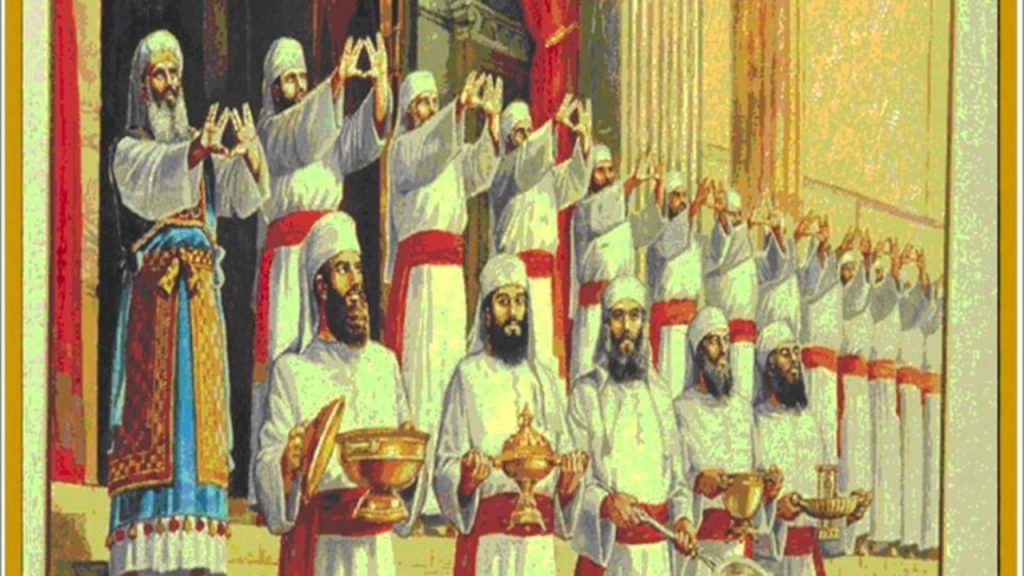In a nutshell
Parashat Korach (Numbers 16:1–18:32.) tells of Korach’s, accompanied by Datan and Aviram, failed attempt to overthrow Mosheh. Joining them are 250 distinguished members of the community, offering ketoret-incense, to prove their worthiness for the priesthood. The earth opens up and swallows them, and fire consumes the ketoret. G‑d commands that a terumah “uplifting” from each crop of grain, wine and oil, as well as all firstborn sheep and cattle, and other specified gifts, to be given to the Kohanim-priests.
The Midrash tells us “Two husbands listened to their evil wives”. They were both rich, Korach was Jewish, Haman was not Jewish. Each had a downfall. Korach’s wife advised him to rebel against Mosheh, he listened to her and persuaded two hundred and fifty man to join him. He and his family were destroyed. Zeresh, Haman’s wife advised him to “build a gallows fifty amos high and hang Mordechai on it”, he listened to her, and he himself was hung on the very same gallows.

Who is Korach?
“Don’t be like Korach”? The Talmud goes so far as to proclaim: “Anyone who engages in divisiveness transgresses a divine prohibition, as it is written: ‘And he shall not be as Korach and his company.'”
Korach was a leading member of Kehatites, the most prestigious of the Levite families. “Two hundred and fifty men of Israel, leaders of the community, of those regularly called to assembly, men of renown” Joined him in his mutiny against Mosheh and Ahron. What exactly did Korach want?
Social Classes of holiness
Mosheh had divided the people of Israel into several classes of holiness:
Ordinary Israelites; the farmers, merchants, craftsmen, soldiers and statesmen of Israel, were to pursue the “normal” existence of physical man in the material world.
The tribe of Levites, Kohanim serving as spiritual leaders and priests, “instructing Your laws to Jacob and Your Torah to Israel; placing incense in Your nostrils and burnt offerings upon Your altar” (Num. 16:9; Deut. 33:10).
Ahron and his descendants (within the tribe of Levi itself) were consecrated as “Kohanim” and entrusted with the primary role in serving G‑d in the Sanctuary. Ahron himself was appointed Kohen Gadol, “the greatest of his brethren” in this hierarchy of holiness.
What exactly did Korach want?
Korach seems to be objecting to this spiritual elitism. His arguments against Mosheh and Ahron seems to be filled with contradiction. On one hand he promotes equality, declaiming to Mosheh and Ahron: “The entire community is holy, and G‑d is within them; why do you raise yourselves over the congregation of G‑d?” railing against a “class system” that categorizes levels of holiness within the community. Yet, in the same breath, he contends that he is the more worthy candidate for the High Priesthood. From Mosheh’s response “Is it not enough for you that the G‑d of Israel has distinguished you from the community of Israel… that you also desire the priesthood?” we learn that Korach actually desired to become the Kohen Gadol!
The Midrash explains: “Why does it not say ‘it was good’ on the second day? Because on that day divisiveness was created; as it is written, ‘it shall divide between water and water.'” However, the Midrash then goes on to point out that on the third day the phrase “it was good” appears twice, because then “the work of the waters,” begun on the second day, was completed.
The Torah
The Torah, was revealed to us 3,333 years ago, at Mount Sinai in the year 2,448 from creation. Our sages tell us that G‑d’s six days of creation correspond to the six millennia of human endeavor that follow. According to Midrash: in the third millennium of the world’s existence, the element that resolves the conflicts created by diversity was introduced into our lives. The Torah. Indeed, the Talmud states that “The Torah was given to make peace in the world.”
The Torah does not blur the distinction between the heaven and earth. In fact, its self-proclaimed task is “To differentiate between the holy and the mundane, between the pure and the impure” (Leviticus 10:10). Nor does Torah endeavor to create a uniform world society: its detailed laws delineate the many different roles man and woman, Jew and non-Jew, Israelite, Levite and Kohen, full-time Torah scholar and layman, etc. to comprise the overall mission of humanity.
Material versus Spiritual life
Even though the Kohen Gadol’s life is wholly devoted to spiritual pursuits while “ordinary” Israelites life is devoted to material pursuits. They both serve the divine purpose no less in the fulfillment of their role than does the Kohen Gadol in the fulfillment of his. We achieve this by living a material life, but doing so in the service of a higher, spiritual goal.
When a person spends ninety percent of his time, living a material life; earning a living, eating, sleeping, recreating, only to enable the ten percent he devotes to prayer, study, charity, he or she is transforming the very nature of the physical realm, and become partner with G-d.
“Korach”, the name, represents an unrepentant sinner. True, even though Korach got lost in his quest, striving for an existence more spiritual than his own, looking at the glass half full, we may also be inspired by him to do better, striving to reach higher level of our own spiritual growth, thus becoming partners with G-d. Kol Tuv.
Check out YedidYah “The Priestly Blessing” Birkat Hakohanim. Music by Rabbi Yakira Yedidia https://youtu.be/YNE11QdEMN0

9 Mitzvot in Parashat Korach
- To guard the Temple area Num. 18:2
- No Levite must do another’s work of either a Kohen or a Levite Num. 18:3
- One who is not a Kohen must not serve Num. 18:4
- Not to leave the Temple unguarded Num. 18:5
- To redeem firstborn sons and give the money to a Kohen Num. 18:15
- Not to redeem the firstborn Num. 18:17
- The Levites must work in the Temple Num. 18:23
- To set aside Ma’aser (tithe) each planting year and give it to a Levite Num. 18:24
- The Levite must set aside a tenth of his tithe Num. 18:26
The 613 Mitzvot
The commandment of the tzitzit. The word tzitzit is related to the root word lehatzitz- to look, therefore a tzitzit is an object at which we look . In addition, the word tzitzit numerical value is 600.
The tzitzit has 8 threads and 5 double knots in each corner (8+5=13), thus a tzitzit represents the 613 mitzvot in the Torah.
In The Torah there are 613 commandments, mitzvot, also known as the Law of Moses (תרי״ג מצוות, taryag mitzvot). The 613 mitzvot are first recorded in the 3rd century CE, when Rabbi Simlai mentioned it in a sermon that is recorded in Talmud Makkot 23b.
The 613 commandments include 248 “positive commandments”, to perform an act (mitzvot aseh), and 365 “negative commandments”, to abstain from certain acts (mitzvot lo taaseh). The negative commandments number 365, which coincides with the number of days in the solar year, and the positive commandments number 248, a number ascribed to the number of bones and main organs in the human body.
Though the number 613 is mentioned in the Talmud, its real significance increased in later medieval rabbinic literature, including many works listing or arranged by the mitzvot. The most famous of these was an enumeration of the 613 commandments by Maimonides, The Rambam.
Many of the mitzvot cannot be observed now, following the destruction of the Second Temple, although they still retain religious significance. According to one standard reckoning, there are 77 positive and 194 negative commandments that can be observed today, of which there are 26 commands that apply only within the Land of Israel. Furthermore, there are some time-related commandments from which women are exempt (examples include shofar, sukkah, lulav, tzitzit and tefillin). Some depend on the special status of a person in Judaism (such as kohanim), while others apply only to men or only to women. According to Rambam Organized by Parshah. based on Wikipedia and http://www.vaadrv.org/rambam613mitzvot.asp ONE BIG IMPORTANT NOTE WHEN USING THIS LISTING: This listing is not all inclusive. Rambam may site multiple sources for a mitzvah is his works but this list currently only gives one source for each mitzvah.

Check out YedidYah Psalm 96 “Yiram Hayam” Music by Rabbi Yakira Yedidia https://youtu.be/aTBD4i9nvXw
The Priestly Blessing
יְבָרֶכְךָ יהוה, וְיִשְׁמְרֶךָ- May the LORD bless you and guard you
יָאֵר יהוה פָּנָיו אֵלֶיךָ, וִיחֻנֶּךָּ -May the LORD make His face shed light upon you and be gracious unto you
יִשָּׂא יהוה פָּנָיו אֵלֶיךָ, וְיָשֵׂם לְךָ שָׁלוֹם- May the LORD lift up His face unto you and give you peace
Yevarechecha Adonai, V’Yishmerecha
Ya’er Adonai Panav Eleycha, ViChoneka
Yisa Adonai Panav Eleycha, V’Yasem Lecha Shalom
(Number 6:24-26).
Check out YedidYah “The Priestly Blessing” Birkat Hakohanim. Music by Rabbi Yakira Yedidia https://youtu.be/YNE11QdEMN0

This blog article was inspired by chabbad.org, Sefaria.org, Wikipedia.org,

